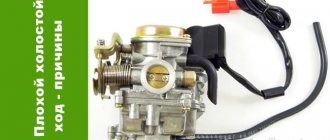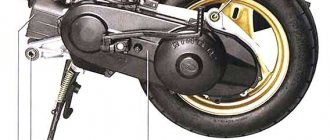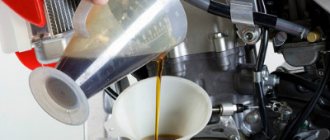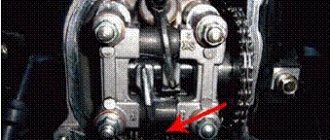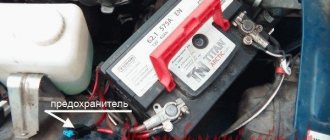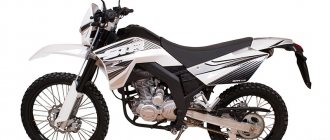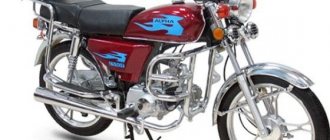The normal operation of a scooter at idle speed depends on many factors, including the condition of the piston, spark plug, carburetor, air filter, muffler, switch, hall sensor, etc.
To know for sure the reason for the unstable idle of your scooter, you need to carry out a series of operations to identify the breakdown and make solutions to fix the problem.
Let's start checking. Adjust the idle speed of your scooter and watch what happens next. Let's look at three possible developments point by point.
Scooter gearbox - design and principle of operation, oil change
The article describes the design and operating principle of a scooter gearbox .
What is a gearbox? A gearbox is a set of gears housed in one common housing called a crankcase. The presence of a crankcase allows for compact arrangement of gear parts, protects parts from mechanical damage and contamination, and provides the necessary lubrication.
What is a gearbox used for? And it is needed to change the speed of rotation of the shafts, down or up.
Gearboxes are installed on all scooters between the output shaft of the automatic centrifugal clutch (read an article about it here) and the wheel.
Figure 1 shows the entire powertrain of the scooter. Circled in red is the gearbox housing 1 with a block of gears 2, 3 and 4. This gearbox is of the two-stage cylindrical gear type, has a fairly high gear ratio and reduces the speed of shaft 4 with wheel 5 several times, while increasing the traction force almost as many times .
And now about the device. On the primary shaft 2 of the gearbox there is a driven pulley of the variator and a centrifugal clutch, and torque from them is transmitted to the same shaft. Next, the torque is transmitted to the intermediate shaft with the gear block 3 and then to the secondary shaft 4 on which the wheel 5 is located. The required amount of engine* (note the article is saved in its original form, but transmission oil is poured into the gearbox) oil for lubrication is poured into the crankcase 1 gears
There are also gearboxes that are of the single-stage cylindrical gear type. The principle of construction of such a gearbox is shown in Figure 2. In it, in the crankcase 1, there are only two shafts instead of the three described above: primary 2 and secondary 3. On the secondary shaft 3 there is a wheel.
Also, in all gearbox housings there is a hole for simultaneously filling and draining oil. Some models have a separate oil drain hole located at the bottom of the crankcase. The role of the filler plug is performed by a simple bolt and washer. The amount (volume) of oil to be poured is often written on the crankcase itself, not far from the plug, and generally for 49 cm3 scooters it is 90-100 grams.
Once a season , check the presence of oil in the crankcase .
In the absence of oil or its low level, an unpleasant hum begins to appear on the side of the gearbox, which leads to rapid wear of bearings and bushings.
We remove the engine.
Specialists, experts or garage technicians begin tuning a scooter with their own hands by dismantling the factory limiters. They are necessary to, firstly, keep the equipment within the established speed limits (Japanese models), and also to increase the service life of the motor. The problem is that you can find this element only after studying your engine model on various forums. The reason for this is the different locations of these same limiters, it could be a blind fork in the exhaust, an electronic limiter installed on the variator or even in the carburetor.
- Plug in the variator. In this case, the part is a special plate mounted on the side of the weights. It prevents the belt from reaching its maximum radius, which means it is impossible to achieve the maximum possible speed. If you have such a part, then by removing it you can significantly increase the maximum speed.
- Limiter in the variator. Sometimes the limiter is the lip on the bushing itself; here you cannot do without the work of a turner. By loosening the limiting edge of the variator, you can increase the speed. Also for many models a ready-made, bored part is sold.
- Carburetor. In this assembly, the plug looks like a valve. With a significant increase in pressure, it opens, thereby preventing the full entry of the air-fuel mixture into the combustion chamber. This can all be treated as in previous options - by dismantling the element or replacing the entire part.
- Exhaust. An interesting restriction system is located in the exhaust. It represents a branch where one of the channels is a dead end. Thus, turbulence and internal pressure in the exhaust increase, which prevents high-quality purging of the combustion chamber. The problem can be solved by brewing dead-end branches.
- Electronic system. Finally, the switch limiter can be considered the most advanced by modern standards. Some Chinese and Italian models can be deceived by cutting the limiter wire, for this you will have to study a lot of literature on electrical engineering. Other models get rid of the problem by simply replacing the unit.
Scooter gearbox
The job of a scooter gearbox is to transmit rotation from the driven pulley of the variator to the rear wheel.
The first gear ratio goes straight through the CVT. The CVT reaches its final ratio (the belt in front goes to the outer radius) by rotating the driven pulley about 5 times per crankshaft rotation (at 10,000 engine rpm, so 50,000 pulley rotations). Presumably, if the wheel were sitting on a driven pulley, then the wheel would have to make 5 full rotations with each ignition (corresponding to the rotation of the crankshaft). The result would be such a long ratio that the motor would not be able to pull. Thus, the importance of the gearbox becomes obvious: by transmitting torque from the driven pulley to the rear wheel, it reduces the rotation speed. How many times? On different scooter models this number may differ slightly, but it is always close to 12, for example on the Yamaha Aerox, to be precise, 12.28, and on the Chinese Baotian Tanco 50 about 11.3. This means that for one revolution of the rear wheel there are 12.28 and 11.3 revolutions of the driven pulley, respectively.
Cleaning the cylinder, boring windows.
Improvement suitable for scooters with two-stroke engines. Their peculiarity is that very often the casting inside the drain and exhaust channels is defective, that is, it has roughness. These shortcomings lead to the fact that the piston is not blown through properly and, accordingly, loses power. Having removed the cylinder and armed with a rolling cutter, you can polish the channels, and then round off the sharp edges on the inside. When tuning scooters, in the photo you can see the differences between the motor before and after polishing. This action will help make the engine work easier at high speeds and potentially add a couple of kilometers to the top speed.
You can go further and increase the diameter of the inlet/outlet windows. For each 2T engine, this parameter is calculated individually. For example, it is enough to bore some 50 cc engines by 1 mm to obtain optimal intake/exhaust parameters. Do-it-yourself tuning of a 150cc scooter and other engine sizes is done in the same way.
How to change the oil in a scooter gearbox?
The rear gearbox of modern scooters has a very reliable and durable design, subject to timely maintenance, of course. All gearbox maintenance work is not very difficult even for beginners, so anyone can do it. Gearbox maintenance involves constant monitoring of the oil level and its timely replacement according to the manufacturer’s recommendations. It is best to change the oil in the scooter's gearbox immediately after a trip, as it will warm up and drain well, thereby leaving a small amount of used oil in the gearbox.
The frequency of changing the oil in the rear gearbox of your scooter should be specified in the instructions; if there are no instructions, you can safely use the general recommendations given below.
First oil change in the gearbox of a new scooter after 300 km
Second oil change in the gearbox of a new scooter after 1500 km.
Subsequent oil changes in the scooter gearbox every 2000 km
The brand of oil should be used strictly in accordance with the recommendations of the manufacturer of your scooter; for most scooters, the manufacturer recommends filling the gearbox with: transmission oil SAE 80W-90 APL GL-5.
Something like this (the oil marking numbers we need are circled in red).
Place the scooter on the central stand so that it stands level, prepare a suitable container, unscrew the drain bolt, drain the oil into the container, in order for the oil to drain completely, you need to wait a while.
Unscrew the drain bolt.
We wait a while until the oil drains completely.
After the oil has completely drained, wipe the drain hole with a clean rag and tighten the drain bolt into place.
Unscrew the inspection hole plug.
We need to pump oil into the gearbox through the control hole; it is more convenient to do this using a 20 ml medical syringe; the approximate volume of oil in the gearbox of a Chinese scooter with a volume of 50-80 cc is 0.1 liters. On some scooter models, oil is pumped through a hole located on top of the gearbox housing.
Exhaust tuning.
It is better to immediately replace the standard exhaust of a scooter with a sports one. Alas, the production of this system is a very precise and labor-intensive process, so it is very difficult to create an effective exhaust, especially for 2t engines, with your own hands. We recommend purchasing ready-made kits in a special store. Well-known models include Laser X, Technical Next or Leovince. With the new pipe, the engine will breathe easier, throttle response at high speeds and maximum speed will increase.
Changing the scooter gearbox oil
A gearbox is a mechanism for reducing the speed of the driven shaft in order to increase torque. Simply put, it converts high clutch shaft RPMs into low (but powerful) wheel RPMs. The gearbox consists of several gears and bearings. All its parts are in constant rotation when driving and are under very serious load.
Therefore, the key to long-term performance of the gearbox is good care of it. Fortunately, maintenance is very simple: you need to change the oil in the gearbox in a timely manner. I believe that the oil should be changed once a year or every 2 thousand km.
In order to change the oil in the scooter gearbox, we will need the following tools:
- container for draining old oil
- key for 10
- a syringe or, at worst, a funnel
- transmission oil
What to fill the gearbox with?
There are three options.
1. There is a special Motul Scooter Gear gear oil. That's what I used at first. The disadvantages of this oil are as follows: the tube has a volume of 150 ml, while in my scooter the gearbox requires 90 ml, that is, one tube is one and a half refills, neither this nor that. And it is inexplicably expensive (about 250 rubles). The only plus: the convenient tube spout.
However, you can use any other automotive gear oil with a viscosity of 80W-90 or 75W-90. For the same money you can buy a liter of “non-scooter” oil, and it will work exactly the same.
2. Since the scooter gearbox does not contain hypoid gears, any motor oil with a viscosity of 10W-30 can be used as transmission oil. Motor oil is even preferable if the scooter is used in the off-season at temperatures below +7 ° C, because it is more liquid.
3. And finally, the most optimal option, in my opinion, is oil for automatic transmissions (ATF), that is, ATF transmission fluid. This oil has the best fluidity (which is especially important at low temperatures, although this is not so important on a scooter), it perfectly protects gears, and has a reduced tendency to foam. Oh yes, it also has a beautiful red color :). The price range for ATF is from 170 to 700 rubles per liter, and for a scooter you can take the cheapest one.
How to drain old oil
First of all, the oil should be changed after a trip so that the sediment rises from the bottom. If your scooter is cold, you can rev it up for a few minutes on the spot.
If the scooter has a drain bolt, everything is very simple: put a container under it, unscrew it, drain the oil, tighten it.
If there is no drain bolt (like mine), then draining and filling is done through a single bolt. In this case, the scooter must be tilted on its side to drain the oil.
Tuning the carburetor and air filter.
The basic principle of driving fast is to burn more gasoline per unit of time, it is suitable for tuning Chinese 4t scooters, Japanese 2t scooters and any other models and types of engines, and the carburetor helps in this, first of all. You can modify the standard unit by installing more efficient jets, but in practice it is better to install more efficient models. Scooter tuning is made easier due to productive models of carburetors produced by DellOrto, a set of pipes and other accessories for them.
A high-performance carburetor will deliver more fuel to the cylinder, and more fuel requires more air. Therefore, the standard filter should be reviewed; it is best to replace the filter element with a new one, while making sure that the entire system is tight. If you are preparing a high-power device, it makes sense to install a minimum resistance filter, but do not forget that it requires constant care, otherwise the filter element will dry out and sand will begin to get into the engine.
Posts 1 page 4 of 4
Share1Wednesday, March 23, 2011 10:09
- Author: Basilisk
- Forum Administrator
- Posts: 249
- From: Khabarovsk
- Phone: 66-73-77
- Registered: Saturday, March 12, 2011
- Time spent on the forum: 6 days 18 hours
- Last visit: Saturday, April 14, 2021 23:02
- Respect: [+2/-0]
- Positive: [+8/-0]
- Age: 28 [1991-11-22]
- Gender: Male
Q. What kind of oil should I put in the scooter gearbox? A. Any transmission with a viscosity of 80W90. Automatic transmission oil is not suitable. Synthetic is better than mineral. The manufacturer doesn't matter. Change after 10,000 km. or once a season.
Q. How to change the oil in a scooter gearbox? A. If the gearbox has 2 holes closed with plugs, then the top one is the filler hole, and the bottom one is the drain hole. Sometimes the drain is located under the variator cover. The oil is drained from below, then diesel fuel is added. The scooter is allowed to run on the stand for about five minutes, lightly accelerating so that the rear wheel spins. After this, the diesel fuel is drained and oil is added. If there is only one hole, you can suck the oil out with a syringe through a dropper or turn the scooter over so that the oil spills out. The oil volume is indicated on the gearbox. If this number is not present, the filler hole serves as a level.
Q. How to break in a scooter after replacing the piston? A. Violent discussions of this topic take place 2-3 times a month. Opinions are polar. Let's look at the following. Good running-in is the key to long engine life. For the first 300-500 km, you should not unscrew the throttle more than halfway. Up to 1000 km, you don’t need to drive faster than 50 km/h and speed up unnecessarily. It is also advisable to add oil to gasoline during the break-in period and not to carry a passenger. You can read more about this, as well as about various exotic methods, below. Q. What kind of oil should I put in the oil tank? A. Special “for two-stroke engines and separate lubrication systems.” It is advisable not to mix different varieties. For low-powered Japanese engines, semi-synthetics are better, for European and tuned engines - synthetics. To save money, you can use mineral water, but the benefits of this are questionable. By an obscure quirk, most MSC members prefer MOTUL and LIQUI MOLY. An example of a lively discussion can be seen below. Q. How to maintain the scooter air filter? A. Quite simple. If you do not have a FNS (zero resistance filter), then maintenance consists of regularly cleaning the foam element and impregnating it with special oil. It is possible to use another oil, but it is unwise, because... A special jar for $10-15 is enough for more than one season. The technology is described in detail below.
WE RECOMMEND TO SUBSCRIBE TO THE CHANNEL
What kind of gasoline should I use?
This is the first problem that absolutely all scooter owners face. According to the passport, you need to fill it with an octane number higher than 90. In our area you can most often find 92 or 95. In principle, 92 will be enough (it contains the least amount of additives that “catch up” the octane number to the required one). The exception will be those scooters in which any gasoline below 95 is contraindicated, so it’s worth looking into your specific model once. Incorrectly selected gasoline can cause a number of problems: from contamination of the carburetor and fuel level sensor, and even to failure of the entire fuel system.
What kind of scooter oil?
2 stroke engine:
In a two-stroke engine, oil is dissolved in gasoline. The main task of which is to provide an oil film for rubbing parts and burn - leaving behind a minimal amount of combustion products.
You shouldn’t be “overthinking” with your choice. Among the relatively inexpensive oils, you can easily find fairly high-quality ones that can be safely refilled.
4-stroke engine:
When choosing oil for a four-stroke engine, you should consider:
- Scooter mileage
- Climate in which the engine will be used
- Engine speed
In the first case, if the engine resource is exhausted and the time for a major overhaul is approaching, experts recommend a mineral base and thicker oils.
I would combine the second and third options and draw the following parallel: if the engine constantly suffers from high speeds or temperatures, you should fill in a thicker lubricant product, which will retain its properties when heated. Conversely, “low-viscosity” oils are poured into engines with moderate climates and non-sporting characteristics. An undeniable advantage of such a lubricant will be its high penetration ability (penetration into metal at the molecular level). This property will give the motor of your scooter a longer life, and you will have a minimum of hassle with repairs.
All-season oils include those that are designated by two digits through W in the SAE classification.
Additives in oil:
In fact, there are not many types of additives used in the production of oils for 2 and 4 stroke engines. We can list a few:
Corrosion protection - special attention to protection during downtime, and naturally during operation. Protection against oxidation - we are dealing with the resulting property of the oil to neutralize the effects of high-temperature and chemical conditions on the lubricant
processes occurring inside the engine, preventing the oil from “aging” ahead of time
Protection against oxidation - we are dealing with the resulting property of the oil to neutralize the effects of high-temperature and chemical influences on the lubricant. processes occurring inside the engine, preventing the oil from “aging” ahead of time.
Reduced dispersion - saves rings from sticking by reducing the concentration of resins and, as a result, no contamination of spark plugs.
Neutralizer for high pressure and wear - includes a detergent additive that will contain burnt particles in suspension (preventing them from settling on the walls throughout the entire period of oil operation), adding strength to the oil film, thereby reducing friction.
Conclusion:
Based on the above (incomplete) list of additives used in two- and four-stroke scooter engines, we can conclude that adding additional additives is very unwise. There is only one reason - everything that the oil needed for good performance properties was included in the recipe class=”aligncenter” width=”402″ height=”414″[/img]
Advice:
Fans of 4-stroke scooters often use conventional automotive semi-synthetic SAE 10W-40 because... their formula is largely identical, the benefit is that there is no need to buy oils for different purposes for a car and separately for a two-wheeled pet.
If the moped is not
Sometimes it happens that the moped does not want to start after several hours of inactivity. However, after warming up, it works and starts stably. Let's figure out why this happens.
When the engine is cold, all clearances (in the piston, in the valves, etc.) are far from ideal. Plus, when fuel gets on cold engine parts, it evaporates worse and therefore ignites worse. Because of this, during a cold start the engine needs a richer mixture than usual. It is for this purpose that devices are made on carburetor engines to enrich the mixture at start-up.
On the Alpha moped (and similar ones), an air damper is installed. It reduces the air flow and thereby enriches the working mixture. The damper has two positions: “closed” - the lever is raised up, “open” - the lever is lowered down. When starting “on a cold” air damper must be closed (lift the lever up). When the engine runs for a while with the throttle closed, it needs to be opened. Driving with the throttle closed will lead to increased fuel consumption and the formation of carbon deposits on the spark plug and piston.
What to do if a cold moped does not start even with the throttle closed? Try using a syringe to fill in 5-7 ml. gasoline directly into the carburetor inlet pipe. If the moped starts after this, then the carburetor needs to be adjusted. If it doesn’t start, check the spark and compression (see above).
Effect of cold weather
The reason why the scooter does not start in cold weather may be a problem with the spark plug cap or its connector. In such a case, the cap is disconnected and the wire is brought a couple of millimeters closer to the metal element of the engine to rotate the crankshaft.
Vehicles in sub-zero temperatures are capable of passing current due to the contact of metal parts with exposed wires, as a result of which the scooter has difficulty starting in cold weather.
Failure in the power system
If you have already tested the occurrence of a spark and the performance of the ignition system, then the reason why the scooter does not start when cold may be hidden in a malfunction in the power system. This may mean either an excessive amount of gasoline supplied, or a lack of it.
The first thing you need to pay attention to is the following elements: fuel valve, gas tank, starting enrichment and gasoline pump
Older models have a fuel tap directly under the gas tank. You need to disconnect the carburetor hose and open the tap, and then if the tank is completely full and gasoline flows out of the hose, then immediately begin inspecting the carburetor. If gasoline does not flow out, then the fault may be in the lines, or in the tap itself; you need to inspect them.
You might be interested in how to make an ATV with your own hands. A detailed description of creating off-road equipment from a motorcycle or car!
In new models, the fuel tap is automatic, operating due to vacuum. The fuel tank here is mounted above the carburetor, and the valve is a device consisting of a membrane, which often fails due to contamination and other things. This type of tap cannot be repaired and requires replacement.
To test the starter enricher, remove it and connect it to a 12v battery. Observe the needle; if it is working, it should smoothly exit the body; if this does not happen, it is faulty.
If all of the above elements are fully operational, proceed to disassembling the carburetor and cleaning it.
If you are experiencing difficulties with repairs, do not refuse the help of friends or contact technical service. It is better to entrust the matter to specialists than to buy unnecessary parts and spoil the existing ones.
Polini Evo 2G
A special word for the favorite among tuning units - Polini Evo 2G. Patented dual shoe technology and an unconventional adjustment mechanism puts this device head and shoulders above the competition. The adjustment technology is simple, like everything ingenious, and at the same time ensures the highest precision of operation. The main difference from all other products on the market is that the springs here work in compression rather than tension - this significantly increases reliability (with the classic layout, springs sometimes break under tension). Plus, the new design made it possible to change the pretension of the springs by rotating the adjusting nuts - you will not find this anywhere else. Pretension is adjustable to the nearest tenth of a millimeter.
Reasons for lack of spark
Often, owners may encounter cases of starting failure in the cold season, although the moped drove well in the autumn. Initially, you need to unscrew the spark plug and carefully inspect for spark, oiliness and color.
Carbon deposits on the electrode
There may be no spark, if the electrode is covered with carbon deposits, then they are cleaned with a metal brush. If there is even the slightest doubt about the serviceability of the spark plug, you should replace it immediately, thereby making your life easier in the future.
Acidification of contacts
If the external signs of the spark plug correspond to suitability, and there is also no spark, then you need to check whether there is a discharge. It is worth noting that you need to be extremely careful, as it can give you an electric shock. If there is no spark and the external signs of the spark plug are normal, then the scooter is checked electronically for acidification of the contacts.
Insufficient fuel
If there is a spark, but the moped still has difficulty starting from the starter in cold weather, you should pay attention to the fuel tank. If it is empty then it is filled
It is worth noting why old gasoline pours out of the carburetor float chamber. How to do it? There is a bolt at the bottom of the carburetor; it is unscrewed, and after all the fuel has flowed out, it is screwed back in. Before putting the moped in the garage in cold weather, fill the tank full of fuel.
Unscrew the bolt and pour out the old gasoline from the carburetor float chamber
If the above has been checked and done, and the scooter does not start well from the starter, then you can make the following repairs:
- The carburetor is removed and the air filter is cleaned;
- The carburetor is cleaned, the jets and channels are purged;
- Everything is coming back together.
Why the Ural motorcycle does not start - compression problems
Most often, the compression on a Ural motorcycle is too low. It does not pump gasoline into the cylinder, so the mixture does not ignite. There are many reasons for leaks:
- — Air comes out through the valve.
- — Air escapes through the gasket.
- — The air escapes through the rings.
It passes through the gasket - pour water on the ribs and there will be bubbles there. In this case, simply replace the gaskets with Ural. If not, take a syringe of engine oil, pour it into the cylinder, using a special agent. We plug it with our finger. Has the compression improved? This means that the answer to the question of why the Ural motorcycle does not start well must be looked for in the rings.
If not, unscrew the lid, first placing a lining under it. Notice that the valve is tightened, because the rod is pushed out a little, and they are not level. The one that is higher is clamped. To adjust the gap, you need to relax the valves both right and left. Gently press the valve with your foot. The valves are relaxed.
Check the gaps with feeler gauges. Find 0.05 mm and insert where the rocker arm connects to the valve. If it doesn't hold, the gap is too big. Let's look at the next one. Unscrew the bolts and take the dipstick. We clamp it between the valve and the rocker arm and tighten it slightly so that it holds the dipstick. Fix the bolt and tighten the nut.
Checking Basic Systems
In order to understand why the scooter does not start, the problem must be looked for sequentially:
- Start with the simplest thing - check the battery charge, if it is normal, proceed further.
- Check if the scooter has gas; it’s easy to forget to fill up.
- See if gasoline is flowing into the carburetor.
- Unscrew the spark plug, inspect it and check if there is a spark.
- If the spark plug is in order, check the coil in the manner described above, turning the starter with the spark plug removed.
- We check the coil and wiring with a multimeter, there may be a break.
- Clean the carburetor and adjust it correctly.
Supply system
After checking the electrics and making sure that everything is in order, you should get to the power system: if the fuel is supplied in the wrong amount, the scooter may not start. If there is a large amount of fuel, the carburetor overflows and the spark plug becomes wet, and if there is little fuel, there is not enough of it for the piston to move. To do this, you need to adjust the jet, floats and needle, moving the limiter on it. It wouldn't hurt to check the gasoline pump either: sometimes it simply fails, so the fuel doesn't go anywhere.
Ignition system
The entire ignition system must be checked if there was a spark and then disappeared. If the spark plug and coil are normal, but there is still no spark, you will have to check more thoroughly. The coil, generator winding, and switch come under suspicion. A multimeter can check all this: for example, they test a generator like this - one probe is connected to the engine crankcase, the second to the generator sensor.
The resistance of a working sensor is 500 Ohms. If the value is higher, the winding is faulty; if it is below 200 Ohms, the problem is in the coil.
The motor belt is damaged
The scooter does not start - there is a spark, there is gas, but there is no reaction.
Another source of the problem may lie in a deformed belt in the motor design. This technical element makes a huge number of revolutions during the day. It is located on the same side as the kick starter, under the motor cover. The belt itself is a consumable, replaceable element of scooters, so sooner or later it will need to be replaced. It cannot be restored; all you have to do is buy a new one at a motorcycle parts store. When purchasing this spare part, it is recommended to pay attention to the overall diameter of the belt and the thickness of the rubber layer - they must correspond to the model of the scooter and its configuration. Otherwise it will not work on your moped
Cylinder-piston group.
Finally, the most effective improvement for any engine is replacing the CPG. But not just a replacement, but the installation of a new, larger piston. Fortunately, there are now many ready-made kits on the market; you don’t have to sharpen or adjust anything, as with Soviet equipment. Moreover, there is even a lot to choose from. For example, for various models with a volume of 50 cubic meters, they offer kits to increase to 63, 72, 82 and even 90+ cubic cm. In some cases, this is an almost double increase in power.
The situation is similar with larger engines, for example, for 125 cubic meters, sets of 150 or 170 cubic meters are sold. Some, in the process of tuning a scooter, manage to increase 150 cubic meters with their own hands to 225 cubic meters. Choosing the right part is not the most difficult thing, the most difficult thing is installing it. After all, this process involves almost complete disassembly of the engine. You will be faced with the need to have several special removable keys in your arsenal; you can ask them from friends or borrow them for the evening at auto repair shops. We strongly recommend studying the technical component in order to properly disassemble, replace the necessary elements and assemble the motor.
